#Fleuriot
Photo
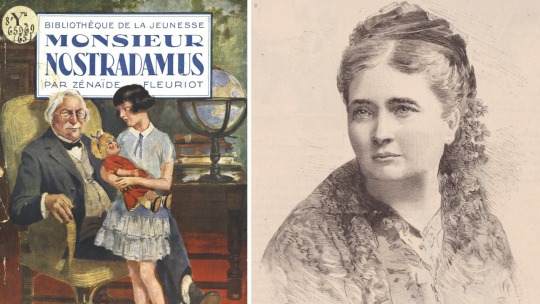
19 décembre 1890 : mort de la romancière pour la jeunesse Zénaïde Fleuriot ➽ http://bit.ly/Zenaide-Fleuriot Au nombre des meilleurs romanciers du XIXe siècle pour la jeunesse, cette Bretonne de talent et d’une grande piété ne doit pas être seulement vue comme une continuatrice de la comtesse de Ségur écrivant, comme elle, dans la "Bibliothèque rose", des contes pour les enfants : les jeunes filles comme leurs parents, émus et charmés, trouvaient toujours un plaisir extrême dans ses oeuvres et y puisaient d’heureux enseignements
#CeJourLà#19Décembre#Fleuriot#Zénaïde#Romancière#Jeunesse#Bretonne#Romans#Filles#Jeunes#Lettres#Littérature#Oeuvres#Enseignement#histoire#france#history#passé#past#français#french#news#événement#newsfromthepast
10 notes
·
View notes
Text


P. 428
Such losers they can’t even make their own fiction hold together.
8 notes
·
View notes
Text



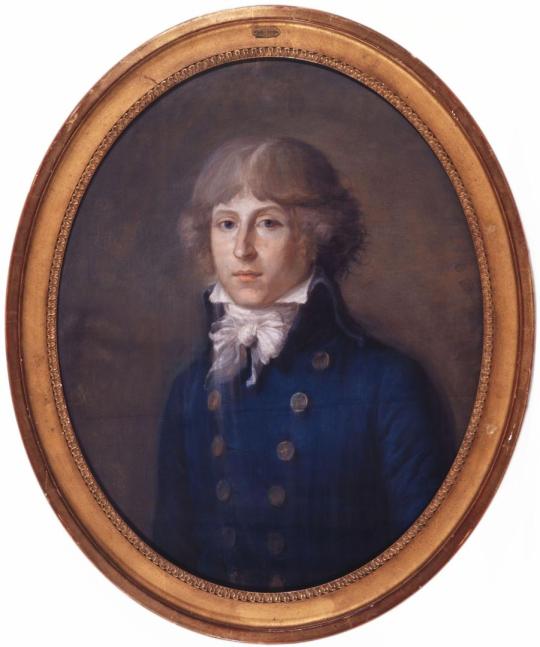
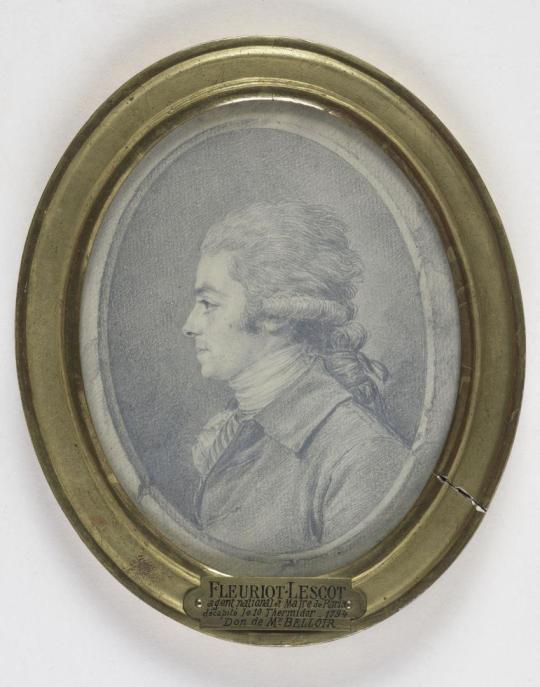
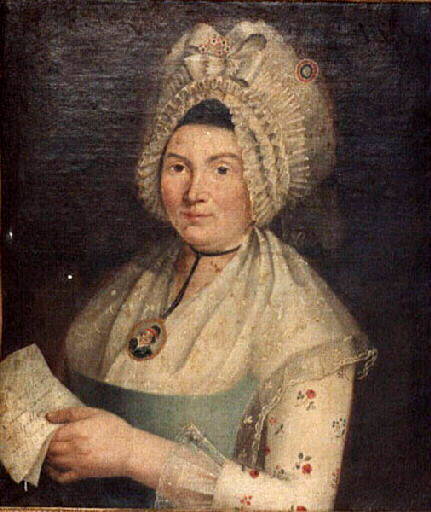
In memoriam.
And many others.
#augustin bon robespierre#georges couthon#philippe le bas#louis-antoine saint-just#jean-baptiste fleuriot lescot#françoise duplay#french revolution#révolution française#thermidor
8 notes
·
View notes
Photo

1816 Jean-Baptiste Jacques Augustin - Suzanne Fleuriot née du Garzpern, Comtesse de Langle, in white dress, holding a bouquet of roses
(Private collection)
168 notes
·
View notes
Video
77 - Lancia Stratos de 1975 by Laurent Quérité
Via Flickr:
RMCH 2024 SR 5 - Lyas - Pourchères Pilote : Nicolas LEROY-FLEURIOT Copilote : Mathilde YVELAIN Col des Croix de Creysseilles Ardèche France IMG_2054
#CanonFrance#Canonphotography#Canon EF 100-400mm f/4.5-5.6L IS USM#Canon EOS 5D Mark II#Voiture#Automobile#Sport Mécanique#Rallye#Cars#carlovers#carphotography#Rallye Monte Carlo Historique#Col des Croix de Creysseilles#Ardèche#France#Lancia#Lancia Stratos#Laurent Quérité#flickr
13 notes
·
View notes
Text
Colin Jones made me so curious about
1. Payan
2. Fleuriot-Lescot
3. Robespierre’s bodyguard group
19 notes
·
View notes
Text
Famous Five Art Nostalgia – Publishing Overview
Introductory post
When I started this series of posts a few months ago, I only had the vaguest idea about the various editions of the Famous Five books that existed over the years in France. The most well-known editions are those from the “Bibliothèque Rose” collection from publisher Hachette – ask anyone on the street (born in the last millennium) and it is probably what they have in mind. But through my searches on the second-hand market – both physical and online – I discovered several additional publications, and even the “Bibliothèque Rose” collection itself saw several variations over the years, giving us a plethora of cover art and inside illustrations to enjoy. Read on to get an overview of the publishing history of the Famous Five books in France (and French-speaking Switzerland)!
The French publisher, Hachette, was founded in 1826 by Louis Hachette as a bookshop and publishing company, first specialising in schoolbooks. In the 1850s, Louis Hachette opened several bookshops in railway stations and started to diversify his offer with serialised novels, travel books and magazines. In 1853, he signed a partnership with the Countess of Ségur (still famous to this day in the world of children’s literature) and subsequently founded the “Bibliothèque Rose” collection (lit. “pink library”) three years later, focused on books aimed to children aged 6-12. 150 years later, Hachette is now the first publishing company in France, and the “Bibliothèque Rose” collection still exists, although it has known many changes over the years.
The first Famous Five book was first published in France in 1955, under the simple title “Le Club des Cinq.” The French publisher did not follow the original English publishing order, and instead chose to publish in priority the books which, I assume, were deemed to garner most traction at the time. The first six books published in France have their original editions in a collection named “Ségur-Fleuriot” (thus named as an homage to two female writers whom Louis Hachette had been working with). These books were pocket-sized, with a hard cover, black-and-white illustrations, and a full-colour dust jacket.

“Ségur-Fleuriot” collection – From left to right:
#02 Five Go Adventuring Again / Le Club des Cinq (1955, ill. Simone Baudouin);
#03 Five Run Away Together / Le Club des Cinq contre-attaque (1955, ill. S. Baudouin);
#04 Five Go to Smuggler’s Top / Le Club des Cinq en vacances (1956, ill. S. Baudouin);
#06 Five Go On Kirrin Island Again / Le Club des Cinq joue et gagne (1956, ill. S. Baudouin);
#07 Five Go Off to Camp / Le Club des Cinq va camper (1957, ill. Paul Durand);
#08 Five Get into Trouble / Le Club des Cinq en péril (1957, ill. S. Baudouin).
(Note: The numbers starting with # correspond to the original English publishing order.)
From what I can gather – even if I find it odd because it doesn’t sound commercially sound – the next books benefitted from a double first edition: one in a collection called “Nouvelle Collection Ségur” with a soft cover, and the other in the above-mentioned “Bibliothèque Rose” with a hard cover. As far as I know, both these editions featured the same inside illustrations, although I have never seen a copy of a “Nouvelle Collection Ségur” book, so I cannot be absolutely sure of this. The red-coloured artwork featuring on the “Nouvelle Collection Ségur” covers were re-used (in black) on the inside title pages of the “Bibliothèque Rose” editions.

“Nouvelle Collection Ségur” – From left to right (in addition to the first six books which joined this collection at some point):
#10 Five on a Hike Together / Le Club des Cinq en randonnée (1958, ill. S. Baudouin);
#12 Five Go Down to the Sea / Le Club des Cinq au bord de la mer (1959, ill. Aldo de Amicis);
#09 Five Fall into Adventure / Le Club des Cinq et les gitans (1960, ill. Jeanne Hives);
#11 Five Have a Wonderful Time / Le Club des Cinq en roulotte (1960, ill. J. Hives);
#13 Five Go to Mystery Moor / La locomotive du Club des Cinq (1961, ill. J. Hives);
#14 Five Have Plenty of Fun / Enlèvement au Club des Cinq (1961, ill. J. Hives);
#16 Five Go to Billycock Hill / Le Club des Cinq et les papillons (1962, ill. J. Hives);
#01 Five on a Treasure Island / Le Club des Cinq et le trésor de l’île (1962, ill. J. Hives);
#18 Five on Finniston Farm / Le Club des Cinq et le coffre aux merveilles (1962, ill. J. Hives);
#19 Five Go To Demon’s Rocks / La boussole du Club des Cinq (1963, ill. J. Hives);
#17 Five Get into a Fix / Le Club des Cinq aux sports d’hiver (1964, ill. J. Hives);
#05 Five Go Off in a Caravan / Le Club des Cinq et les saltimbanques (1965, ill. J. Hives) [not featured];
#20 Five Have a Mystery to Solve / Le Club des Cinq et le vieux puits (1966, ill. J. Hives) [not featured];
#21 Five Are Together Again / Le Club des Cinq en embuscade (1967, ill. J. Hives).
If you count carefully, the 6 books from the “Ségur-Fleuriot” edition added to the 14 books from “Nouvelle Collection Ségur” make for a total of 20… out of 21 from the original English series! Where is the last book?? Well, the missing book (namely #15 Five on a Secret Trail / Le Club des Cinq se distingue) benefitted from a higher-end edition called “Idéal-Bibliothèque,” featuring a larger-size format, hard cover, better-quality paper, a dust jacket, and more numerous illustrations. A second book joined this upgraded edition a year later.

“Idéal-Bibliothèque” collection:
#15 Five on a Secret Trail / Le Club des Cinq se distingue (1961, ill. J. Hives);
#08 Five Get into Trouble / Le Club des Cinq en péril (1962, ill. J. Hives).
The “Bibliothèque Rose” editions, featuring hard covers, 4 to 6 full-page colour art, and several black and white illustrations, are the most well-known to this day.
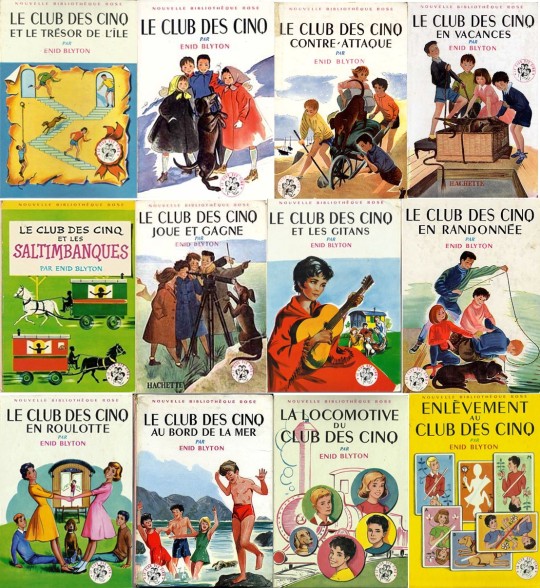
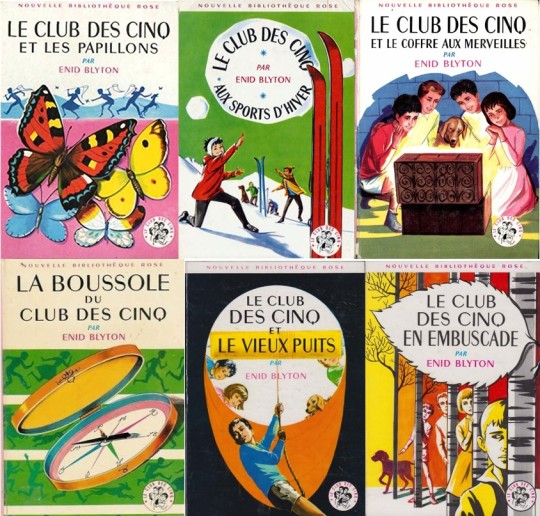
“Bibliothèque Rose” original editions from 1958 to 1967, featuring artwork from the four original illustrators
(Note: Covers sorted according to the original English publication order, as it is very difficult to pinpoint the exact French publishing order due to the many re-editions.)
The series became wildly popular and benefitted from several re-editions, some of them with new cover art produced by the then-current illustrator, Jeanne Hives.

Some “Bibliothèque Rose” re-editions from 1965-1969, featuring new cover art by Jeanne Hives
The 1970s saw a renewal of the “Bibliothèque Rose” collection with the arrival of illustrator Jean Sidobre who, over the next 15 years, produced numerous covers for all 21 books and, in time, produced the full set of inside illustrations. In these newer editions though, the number of full-page colour illustrations was reduced to four due to economic constraints.



Various cover art by Jean Sidobre from 1971 to 1985
(Note: The third cover for '#03 Five Run Away Together / Le Club des Cinq contre-attaque' is not from Sidobre but from another illustrator, called Annie-Claude Martin.)
Back in the early 1970s, thanks to the series’ popularity, some of the books were published in a larger size format featuring several more colour illustrations and some black and white ones. These editions were respectively called “Galaxie” and “Vermeille” and were both illustrated by Jean Sidobre. Some of the art is the same as in “Bibliothèque Rose” above, and some is new. You will notice that the two books from the “Galaxie” edition are also part of the “Vermeille” edition; my guess is that they started these upgraded editions as “Galaxie”, but for some reason decided that “Vermeille” was better, and so they fitted the first two books into the developing new collection – as far as I can figure out, the contents of these two books are the same under “Galaxie” and “Vermeille”, the only difference being the cover art.

“Galaxie” collection:
#02 Five Go Adventuring Again / Le Club des Cinq (1971, ill. J. Sidobre);
#21 Five Are Together Again / Le Club des Cinq en embuscade (1972, ill. J. Sidobre).

“Vermeille” collection:
#18 Five on Finniston Farm / Le Club des Cinq et le coffre aux merveilles (1973, ill. J. Sidobre);
#21 Five Are Together Again / Le Club des Cinq en embuscade (1974, ill. J. Sidobre);
#02 Five Go Adventuring Again / Le Club des Cinq (1974, ill. J. Sidobre);
#01 Five on a Treasure Island / Le Club des Cinq et le trésor de l’île (1975, ill. J. Sidobre);
#17 Five Get into a Fix / Le Club des Cinq aux sports d’hiver (1975, ill. J. Sidobre);
#09 Five Fall into Adventure / Le Club des Cinq et les gitans (1975, ill. J. Sidobre);
#04 Five Go to Smuggler’s Top / Le Club des Cinq en vacances (1975, ill. J. Sidobre).
The 1980s saw a drop in “Bibliothèque Rose” sales as kids were moving from books to TV and video games. To boost sales, the publisher made several changes to the look and format of the books, and the original text was sometimes abridged.
In 1988, as sales continued to fall, and to save money, Hachette changed its “Bibliothèque Rose” hardbacks to a softcover pocket format. The inside colour illustrations disappeared and the black and white ones decreased in number (re-using former art from Sidobre). On the upside, these editions saw a series of new cover art from a different illustrator, Yves Beaujard, whose art style on these covers is very similar to Sidobre’s, which leads me to think that this was a requirement from the publisher who wanted a certain consistency between Beaujard’s cover art and Sidobre’s inside illustrations.
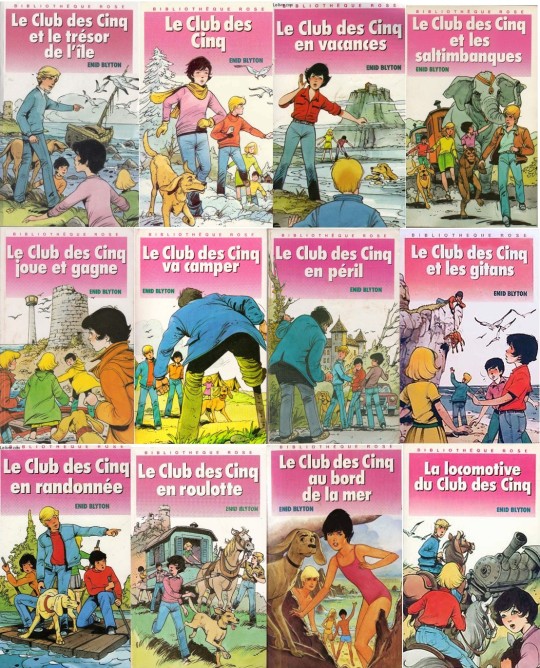

From 1988 to 1992, the whole series benefitted from new cover art by Yves Beaujard (with the exception of ‘Le Club des Cinq au bord de la mer’ and ‘Le Club des Cinq et les papillons’, which re-used former art from Jean Sidobre)
(Note: As far as I know, ‘#03 Five Run Away Together / Le Club des Cinq contre-attaque’ was never included in this edition.)
In the 1990s, a series of new cover art was produced by Paul Gillon, with the same general layout as the previous edition. The inside black and white illustrations are either former art by Sidobre or new art by Anne Bozellec.


Cover art by Paul Gillon from 1991-98
In 2000, Hachette celebrated the new millennium with a new style for its “Bibliothèque Rose” collection, featuring a hybrid format between hardback and softback adorned with a glossy aesthetic. The inside illustrations are the same as the previous editions, by Sidobre or Bozellec.

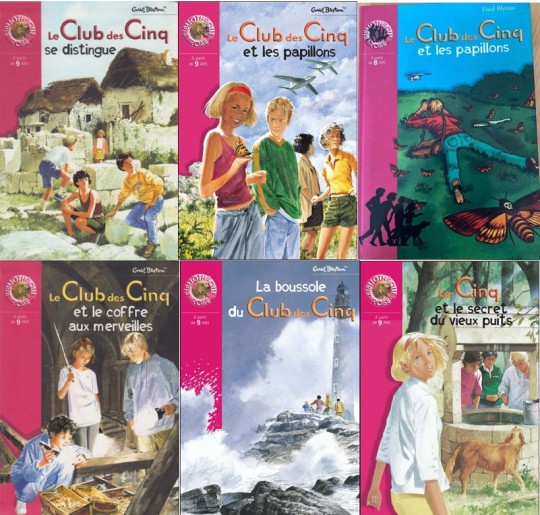
Cover art by Philippe Munch and Jame’s Prunier from 1999-2004
(Note: As far as I know, ‘#10 Five Go on a Hike Together / Le Club des Cinq en randonnée’, ‘#11 Five Have a Wonderful Time / Le Club des Cinq en roulotte’, ‘#12 Five Go Down to the Sea / Le Club des Cinq au bord de la mer’, ‘#17 Five Get into a Fix / Le Club des Cinq aux sports d’hiver’ and ‘#21 Five Are Together Again / Le Club des Cinq en embuscade’ were never included in this edition.)
In the mid-2000s, the morality police made their way through the books, resulting in watered-down translations and some title changes. Frédéric Rébéna did a series of new cover art. The inside illustrations all but disappeared, only featuring as small vignettes at the opening of each chapter.


Cover art by Frédéric Rébéna from 2005-11
In the 2020s, the series changed from “Bibliothèque Rose” to “Bibliothèque Verte” collection with new cover art by Auren.
Similar to “Bibliothèque Rose,” “Bibliothèque Verte” (lit. “green library”) was another historically popular collection from publisher Hachette, initially aimed toward a teenage male readership, while “Bibliothèque Rose” was leaning toward a younger and female audience. Nowadays, the line between what is deemed appropriate reading material for boys or girls has thankfully blurred and both collections are now thematically oriented, “Bibliothèque Rose” focusing on humour/emotion and “Bibliothèque Verte” on action/adventure. Hence the marketing decision that caused the Famous Five series to lose its historical pink palette.


Cover art by Auren from 2019-21
And that’s a wrap for the main French editions! But there’s still a few more to go through.
First is France Loisirs, a book sales club to which you can register and you will receive a certain number of books each month. I do not know if the whole series was ever fully published by France Loisirs; the visuals that you will find below are all that I could find. The books are hardbacks with a dust jacket and without any inside illustrations. From what I could gather, they were published from 1975 to the early 1980s. The illustrator is called J.P. Morvan and, if you look closely, often took inspiration from earlier “Bibliothèque Rose” illustrations by Jean Sidobre.

“France Loisirs” edition from 1975-82 with cover art by J.P. Morvan
In the 1990s, France Loisirs published another batch, re-using cover art by Paul Gillon from the contemporary “Bibliothèque Rose” edition. I’m a bit fuzzy on the exact dates, but these were published from the early to mid-1990s to around 2000. I do not know anything about the books themselves, but I can assume that they contain only plain text without any inside illustrations.

“France Loisirs” edition from the 1990s featuring art by Paul Gillon
Last on our exploration of “Famous Five” French publishing is actually not French at all! But I’m including it in this post because it uses the same French translations as Hachette.
This particular edition is from a publisher named “Edito Service SA, Genève”, which you may have guessed is from Switzerland. I don’t have a lot of information about its history and only learned about its existence because some of these books made it through the border into France, and from there onto the online second-hand market. The books each contain 5 illustrations by Umberto Nonna (3 black and white and 2 full-colour), and they come both in softback and hardback formats. They were published in 1981-82.
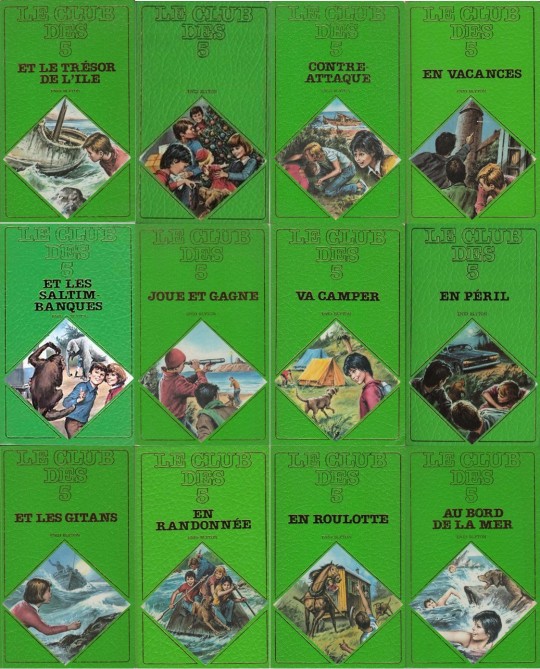

“Edito Service” edition from 1981-82 (softbacks)

“Edito Service” edition from 1981-82 (some of the hardbacks)
(Note: Despite what the above pictures suggest, all the hardback covers have the same dark green background.)
Thank you for your attention, and see you soon!
~~~~~~
We’ve now truly come to the end of this deep-dive into Famous Five French publishing.
#papillon82 reads#famous five art nostalgia#famous five#le club des cinq#illustrations#publishing overview#hachette#simone baudouin#paul durand#aldo de amicis#jeanne hives#jean sidobre#annie-claude martin#enid blyton#yves beaujard#paul gillon#anne bozellec#philippe munch#jame's prunier#frédéric rébéna#auren#jp morvan#umberto nonna#whew this post was a long time coming!#I have another post ready to go but I'd like to have more of a buffer before I resume my posting schedule#hopefully our regular posting schedule will resume next Sunday#until then have a great week!
8 notes
·
View notes
Text
Contemporary descriptions of the Robespierrist execution compilation
(from description closest in time to the execution to the one furthest away)
Today, Monday afternoon, Robespierre and his 21 conspirators are taken to the Revolutionary Tribunal to have their condemnation confirmed, because, being outlaws, their trial is over. It is decreed that they will be put to death at Place Louis XV, today Place de la Révolution. They were taken there and passed along rue Saint-Honoré and everywhere they were insulted by the people, indignant at seeing how they had deceived them. And they had their heads cut off at 7 o'clock in the evening. In 24 hours it was done; they hardly expected to die so quickly, those who wanted to massacre 60 000 men in Paris. This is how God lets the scoundrels, at the moment of executing their projects, perish. Robespierre was the soul of the conspiracy with another villain, Couthon, who assisted him. It is said that he wanted to recognize himself as King in Lyon and in other departments and marry Capet's daughter. How can a private individual put such a project in his head? Ambitious villain, that's where your pride has led you. With him dying as leader of the conspiracy, everything falls with him.
Journal de Célestin Guittard de Floriban, bourgeois de Paris, sous la Révolution, présenté et commenté par Raymond Aubert (1974) page 437-438. Cited in Comment Sortir de la Terreur - Thermidor et la Révolution. Diary entry July 28 1794.
It was around six o'clock in the evening that the tyrant and twenty-one of his principal accomplices left the Conciergerie to advance towards the scaffold. They were in three tumbrils: Hanriot, drunk, as usual, was beside Robespierre the younger; the tyrant was next to Dumas, the instrument of his fury; Saint-Just sat close to the mayor of Paris; Couthon was in the third tumbril. Hanriot and Robespierre the younger had their heads smashed and were covered in blood; Couthon had a bandeau; the tyrant had his whole head, except his face, bandaged, because he had received a pistol shot in the jaw. It is not given to a man to be more hideous and more cowardly: he was dull and downcast. Some compared him to a muzzled tiger, others to Cromwell's valet, for he no longer had the countenance of Cromwell himself. All those around him had, like him, lost their audacity. Their baseness added to the indignation against them. We remembered that, at least, the conspirators who preceded them had known how to die. They did not even have the strength to speak to each other, nor to address the slightest word to the people. The crowd was innumerable; the accents of joy, the applause, the cries of: A bas le tyran! Vive la République!, imprecations of all kinds resounded from all sides along the way. The people thus avenged themselves for the eulogies commanded by terror, or for the homage usurped by a long hypocrisy. It was about half past seven when the traitors arrived at the Place de la Revolution. Couthon was executed first; then Robespierre younger; the head of the tyrant was the penultimate, and that of Fleuriot Lescot the last. They were shown to the people, who made the air resound with long prolonged cries of Vive la Convention! Vive la République!”
Suite de journal de Perlet number 675 (July 30 1794)
From 11 Thermidor — Yesterday, around half-past seven in the evening, the twenty-two conspirators arrived at the place of execution, Place de la Révolution, amid prolonged and unanimous cries of Vive la République! Robespierre the elder had his head wrapped in a bandage and bloodied from a pistol shot he had fired at himself when he saw himself abandoned by the traitors Hanriot had arranged for him. This one was also all scarred on the face and injured in the arms from the defense he had put up against the gendarmes responsible for arresting him. Only Lebas, former deputy, killed himself. The heads of Robespierre, Hanriot, Dumas and a few others were shown to the people, who, during the whole course of the journey of these infamous conspirators, from the Palais de Justice to the scaffold, bore witness to them in the most energetic of all its indignation and all its horror.
Courrier républican, July 30 1794
It was the evening before last, at seven o'clock, that Maximilien Robespierre, his brother, Saint-Just, Couthon, Hanriot, Fleuriot, mayor, Payan, national agent, Dumas, Lavaleyte, Coffinhal, Bernard, Gobeau, Geney, Vivier, Simon, Laurent, Wouarmé, Forestier, Guérin, D'Hazard, Bourgon and Quenet, municipal, were executed. Lebas had killed himself. Never have we seen such a crowd of people as at this performance. Women, children, old people, all of Paris was there. Who could return the joy which burst on all faces? In all the streets through which the conspirators passed, in the whole extent of the Place de la Révolution, everywhere there was only a unanimous cry: Ah! the scoundrels! Vive la République! Vive la Convention! and all the hats were up in the air in satisfaction. Eyes were particularly fixed on Maximilien Robespierre, Couthon and Hanriot, whose heads were bloody from the wounds they had received at the time of their arrest.
Annales de la République française, July 30 1794
The torment of a tyrant is truly a feast for the world. The French have made it a decade-long celebration, and the joy of yesterday proved how long and strong the oppression had been under which all souls, all hearts, all spirits had groaned. Yes, public joy developed yesterday in all its fullness and guarantees us freedom forever. Neither the punishment of Louis XVI, nor that of his wife and of all the traitors who have since suffered the fate of treason, nor any celebration, not even those of victories, had had so many spectators, had inspired a joy as felt, as universal, as expansive as the misery of Robespierre, Couthon, Saint-Just, etc. How horrible must the long passage from the Palais de Justice to the Place de la Révolution, in front of an immense people applauding, shouting incessantly: Vive la République! Perish the traitors and the hypocrites always speaking of virtue, and having crime in their hearts! have been for them (if they were still susceptible to any shame). If they had been able to see in the National Garden all the citizens returning from their torture, throwing themselves into each other's arms, embracing each other, congratulating each other on finally being delivered from an odious yoke, crying out , repeating everywhere: ”Finally, we are free, we will no longer poison our thoughts, our intentions; our mistakes will no longer be turned into crimes; the interior of our households will at least be a safe haven against the espionage of denunciation; sweet intimacy, brotherhood, friendship and their consoling charms will be returned to us; the tyrant is no more!” If they could have seen all this, I say, they would have shuddered with rage at having so grossly deceived themselves by counting on a perished people to serve their projects of domination and subjugation.
Journal des hommes libres de tous les pays, July 31 1794.
Robespierre and his principal accomplices had been arrested towards the middle of the night between 9th and 10th Thermidor. They were handed over to the executioners on the morning of the 10th. The procession left the Palace of Justice, and set off about five o'clock in the evening. Never had one seen, on the passage of the tortured, such an influx of people. The streets were clogged. Spectators of all ages and sexes filled the windows; men were seen climbing up to the tops of the houses. Joy was universal. It manifested itself with a kind of fury. The more the hatred felt for these scoundrels was suppressed, the louder the explosion. Everyone saw in them his enemies. Everyone applauded drunkenly, and seemed to regret not being able to applaud more. One thanked Heaven, one blessed the Convention. The horsemen who escorted the patients shared the universal joy; one even saw, in this meeting, what one had never seen before: these horsemen waved their sabers in sign of joy, and accompanied this movement with the cry: Vive la Convention! Eyes were especially attached to the cart which carried the two Robespierres, Couthon and Hanriot. These poor things, mutilated and covered with blood, resembled bandits whom gendarmes had surprised in a wood, and could therefore only seize by wounding them. Robespierre, extraordinarily pale, and covered with the same coat he wore on the day when he had dared to proclaim, at the Champ de Mars, the existence of the Supreme Being, lowered his eyes, and leaned his head, which looked horribly deformed by the dirty, bloody linen that enveloped him, on his chest. Hanriot, having no clothing but a shirt and a waistcoat, was covered with mire and blood. His hair, his bloody hands, the eye which was only held together by filaments, formed a picture so disgusting and so appalling, that one didn’t dare to stare at him for a long time. “Here he is, here he is,” said the people, “as he was when he left St-Firmin, after having cut the throats of the priests there!” Robespierre the younger and Couthon were likewise disfigured by bruises, and covered with blood. The horrible deformity with which all these unfortunates presented themselves to the eyes of their fellow citizens at the last moment of their lives, appeared to even the least religious man a chastisement from heaven. Men, in fact, who after having bathed in blood, were completely defiled by descending to the tomb, testified in a striking manner that divine justice exercised its terrible vengeance on them, and wished to inspire great horror in their assassinations. The procession having arrived in front of the house where Robespierre was staying, the people compelled the executioners to stop. They obeyed. A group of women then performed a dance in front of the cart carrying Robespierre. When the patients had reached the middle of the former royal street which leads to the execution, a woman of middle age, neatly dressed, and showing by her manners and her countenance an education above the common, sprung from the crowd , seized with one hand the bars of the cart where Robespierre was, and threatened him with the other, and cried to him: "Monster spewed up from hell, your supplication intoxicates me with joy. I have only one regret, you don't have a thousand lives to enjoy the pleasure of seeing them all snatched one after the other. Go away, scoundrel; descend to the tomb with the curses of all the wives, of all the mothers!” Robespierre had without a doubt deprived this woman of a husband or son. He looked languidly at her, and without saying a word, shrugged. On the scaffold, Robespierre had a new suffering to endure. The executioner, before stretching him out on the board where he was going to receive death, abruptly tore from him the bandage placed on his wounds. The lower jaw was thus detached from the upper jaw, causing waves of blood to flow, which made the head of this unfortunate man a monstrous object. When this head had been cut off, it presented the most horrible picture that one can paint. Hanriot had to suffer a no less painful torture: one of the executioner's servants, before he mounted the scaffold, brutally tore out his eye where he had been wounded. Each falling head excited loud applause. The number of those executed that day was twenty-two.
Histoire de la conjuration de Maximilien Robespierre (1795) page 221-225. The descriptor, Galart de Montjoie, was 48 years old by the time of the execution. According to wikipedia, he was forced to go into hiding in Bièvres in April 1793 due to writing royalist pamplets. This means he might not have actually been an eye witness during thermidor.
At four o'clock in the evening the sinister procession left the courtyard of the palace. Never have we seen such an affluence of people. The streets were clogged. Spectators of all ages and sexes filled the windows; men were seen climbing up to the tops of the houses. Joy was universal. It manifested itself with a kind of fury. The more the hatred felt for these scoundrels was suppressed, the louder the explosion. Everyone saw in them his enemies. Everyone applauded drunkenly, and seemed to regret not being able to applaud more. Eyes were especially attached to the cart which carried the two Robespierres, Couthon and Hanriot. These poor things, mutilated and covered with blood, resembled bandits whom gendarmes had surprised in a wood, and could therefore only seize by wounding them. It was noticed that Robespierre had, in going to scaffold, the same tailcoat as he had had on the day when he had proclaimed the existence of the Supreme Being at the Champ de Mars. It is difficult to paint his appearance. Nothing recalled the idea of the supreme power which he exercised twenty-four hours earlier. He was no longer the tyrant of the Jacobins, nor the insolent ruler of the Convention; he was a wretch, whose face was half covered by a dirty and bloody linen. What one perceived of his features was horribly disfigured. A livid paleness completed his frightful appearance. Whether he was overwhelmed by the pains caused by his wounds, or whether his soul was disheartened by the remorse caused by the memory of his crimes, he affected to have his eyes lowered and almost closed. It was in this condition that he crossed the streets and Rue Saint-Honoré. Arriving in the middle of the former royal street, he was pulled from the lethargy in which he was by a circumstance which deserves to be preserved by history. A woman was waiting for him in this place. She was neatly dressed and of middle age. Seeing the tumbrel carrying Robespierre, she pushed through the crowd and seized the bars of the tumbrel with one of her hands. The countenance and expression of this woman announced that she had received the best education. Attached to the tumbrel by one of her hands and shaking Robespierre with the other, she cried out to him: "Monster spewed up from hell, your supplication intoxicates me with joy." At these words, Robespierre half opened his eyes and shrugged his shoulders. “Abominable monster,” continued this woman, ”I have only one regret, you don't have a thousand lives to enjoy the pleasure of seeing them all snatched one after the other. ” This new apostrophe seemed to importune Robespierre; but he did not open his eyes. Then the brave woman said to him as she left him near the scaffold: ”Go away, scoundrel; descend to the tomb with the curses of all the wives, of all the mothers!” It has been presumed that Robespierre saw this woman deprived of a husband or a son. Her painful accents must have penetrated his soul. This moral torture was no doubt very weak to expiate crimes as enormous as those of which Robespierre had been guilty; but it was at least a satisfaction for sensitive souls to learn that this monster had experienced it, and that it had been able to increase the horror of the too severe torture which he had to undergo. When the tumbril arrived at the foot of the scaffold, the executioner’s assistants lifted down the tyrant and laid him on the ground until it was his turn to meet death. One observed that during the time his accomplices were being executed, he didn’t show any sign of sensibility. His eyes were constantly closed, and he didn’t reopen them until he felt himself transported to the scaffold. They say that in perceiving the fatal instrument he uttered a painful sigh, but before receiving death, he had a cruel suffering to endure. After having thrown away his tailcoat, which was crossed over his shoulders, the executioner teared off the bandage that the surgeon had put on his wounds. The lower jaw was thus detached from the upper jaw, causing waves of blood to flow, the head of this poor thing wasn’t more than a monstrous and disgusting object. Once this appalling head had been cut off, and the executioner took it by the hair to show it to the people, it was the most horrible image one can imagiene.
Les Crimes de Robespierre et de ses principeax complices (1797) page 121-126. The descriptor, Nicolas Toussaint Le Moyne Des Essarts (1744-1810), was 49 by the time of the execution. This is clearly a variation of Montjoie’s account to some extent.
Where shall I find the true colors with which to paint a picture of the public happiness that existed in the midst of this terrible spectacle, to describe the explosion of burning joy that spread and resounded as far as the scaffold itself? His name, accompanied by curses, is in every mouth; they no longer called him the Incorruptible, the virtuous Robespierre, the mask has fallen away. They execrate him, they blame him for every crime of both committees, they surge forward from the shops, boutiques, and windows. Rooftops are covered with people, thronged by a huge mob of spectators drawn from every class of society, all with only one desire, to see his death. Instead of sitting on a dictator’s throne, he is half-sitting, half-lying in the tumbrel that also holds his accomplices, Couthon and Hanriot. The noise and tumult that accompanies him is composed of a thousand cries and mutual congratulation. His head is enveloped in dirty bloodstained bandages; only half of his pale, ferocious face is visible. His mutilated, disfigured companions look less like animals than wild beasts caught in a trap. Even the burning sun cannot deter the women from exposing the lilies and roses of their delicate cheeks to its rays; they want to see the executioner of these citizens… On the scaffold, the executioner, as if spurred by the public’s hatred, roughly tears away the bandage covering his wounds; he roars like a tiger; his lower jaw snaps off from the upper jaw and blood spurts out, changing this human head into the head of a monster, the most horrible sight imaginable. His two companions, no less hideous in their torn, bloodstained clothing, were the acolytes of this famous criminal, for whose suffering no one can summon a vestige of pity… The crowd surged forward, so as not to miss witnessing the exact second when his head would go beneath the blade, that blade to which he himself had sent so many others. The applause lasted for more than fifteen minutes. 22 heads fell with his.”
Le nouveau Paris (1797) volume 6 page 101-104. The descriptor, Louis-Sébastin Mercier (1740-1814) was 54 by the time of the execution. Note that he was actually in prison during Thermidor, and thus cannot really be considered an eye witness.
Taken to the Conciergerie, and a few hours later brought before the Revolutionary Tribunal, which was only to establish his identity, he (Saint-Just) was sent to the scaffold on the evening of 10 Thermidor (July 28, 1794). He marched to the execution with calm and firmness, casting his gaze disdainfully over the immense crowd which served as his escort, and seeming entirely insensitive to the vociferations of the multitude, as well as to the insults heaped upon him by some men who, a few days before, were his accomplices or the servile instruments of his crimes. When his guilty head fell on the scaffold, which he himself had so long watered with innocent blood, Saint-Just was still only 26 and a half years old.
Biographie nouvelle des contemporains (1827) volume 18 page 558. The descriptor, Antoine Vincent Arnault, was 28 by the time of the execution.
The pen can only give an imperfect idea of what passed around this poor thing, from the tribunal, where his identity was ascertained, to the place where he satisfied the national vindictiveness. On this road, still deserted the day before when the condemned men passed by, everywhere he met the crowd who, to see him, crowded under the wheels of the tumbrel, slowing down its progress. There wasn’t a look that didn't strike him down, a mouth that didn't insult him, a fist that didn't rise to threaten him. The tongues, so long chained, were loosed; hatred had broken the silence which terror had commanded for twenty months; and as each had only a short time to satisfy such long resentments, each hastened to expectorate the curses heaped up for so long in his heart. Terrifying concert! We had never seen the example of such unanimity: no voice rose to pity him; no face expressed compassion; and yet he was in a pitiful state! A pistol shot had shattered his head, leaving him only enough life to suffer, to feel the pain of his wound and the terror of his inevitable fate. Isolated in the midst of his party, he did not even have the friends that crime gives. Struck with the same blow as he, his accomplices had no more pity for him than he had pity for them. As ferocious as everyone else, I ran to the place of execution, less, however, to feast my eyes on the sufferings of this monster than to convince myself with my eyes of the death of the one whose life threatened that of anything that had life. I ran there to seek certainty that he had not escaped like the day before. I found it. A cry which the pain wrung from him, when the device which covered his wound was removed, broke for the first and the last time the silence which he had kept for twenty-four hours; and at the same moment, from the same place where I had seen Danton disappear, I saw Robespierre disappear. That day did not stop the shedding of blood, but from that day, at least, innocent blood ceased to flow. Before Robespierre's head, several heads had fallen, and among others those of the proud Saint-Just, the sweet Couthon, the ignoble Henriot, and also that of Robespierre the younger, who, accomplice in his revolt, had not been of his tyranny. Public exasperation was so great on this day of revenge, that so generous a devotion, however odious its object, did not even obtain pity. No circumstance, no incident, moreover, gave the execution of Robespierre a character different from that which it was to have had. Danton is ennobled in his last moments; Danton mounted as a hero the horrible trestles to which crime had led him; his courage turned it into a theatre. There was only a scaffold for Robespierre. The universal feeling about the end of this forever execrable man is quite well expressed in this naive epitaph: “Passerby, do not mourn my fate; If I lived, you would be dead.”
Souvernirs d’un sexagénarie (1833) volume 2 page 105-108. The descriptor, Antoine Vincent Arnault, was 28 by the time of the execution.
”During the fatal journey, Robespierre’s head was wrapped in a bloody linen, so that you could see only half of his pale and livid face. The horsemen of the escort showed him with the points of their sabers to people eager to see him in this horrible state. When he had arrived at the scaffold, the executioners ripped of the bandage that supported his lower jaw, and snatched from him, with the deepest pain, the only cry that he had uttered during his long agony. This man, that his enemies without cease had represented as shy and even heartless, retained his firmness until the last moment, and fell under the blade without having given the slightest sign of terror. Saint-Just, whom Robespierre draggad with him in his downfall, died with his full constance. None of the outlaws showed weakness. With each cut of the blade, the applause testified the ferocious joy of the spectators, since long too accustumed to eagerly contemplate scenes of carnage. Maximilien Robespierre was 35, Saint-Just 26, Robespierre the younger the same age.”
Historie complète de la Révolution française (1834) volume 5 page 325-326. The descriptor, Pierre-François Tissot (1768-1854), was 26 years old by the time of the execution.
The scaffold had been erected in the Place de la Révolution. An immense crowd covered the streets where the procession was to pass, as well as the place of execution. Among Robespierre's enemies, who followed the cart in which he was dragged, and who overwhelmed him with insults and imprecations, Carrier distinguished himself by this continual and furious cry: Death to the tyrant! Robespierre and those who shared his destiny showed perfect impassivity. When he had ascended the steps of the scaffold, the executioner violently tore from him the apparatus which covered his wounds, and delivered him up for a time, pale, disfigured and bleeding, to the gaze of the multitude. 21 of his supporters were guillotined that day with him. We give their names in the lists of the Revolutionary Tribunal.
Portrait de Robespierre by anonymous, cited in Histoire Parlamentaire de la Révolution Française (1834-1838) volume 34 page 96-97
I can never forget the day of his execution. The crowd that lined the streets he passed through was immense, and the shouts of joy and vengeance were deafening. I could not make my way to witness his last moments; but it is said to have been a most horrid sight. The executioner tore off the dressings of his fractured jawbone with such brutal violence, that his roar of agony, like that of a wounded lion, or rather tiger, was heard at an incredible distance.
Recollections of Republican France 1790 to 1801 (1848) page 317. The descriptor, J.G Millingen, was twelve years old by the time of the execution.
I saw the carts containing the doomed men with their escort proceed on their way through the Rue Saint-Honoré to go to Place de la Révolution. The immense throng obstructed the streets and was an obstacle to the rapid progress of the procession, but the prevailing feeling was not only that of unanimous rejoicing, but of deliverance, and yet this feeling did not venture to break out in words and escape from the hearts so long oppressed until it had become a recorded fact that the ”head of Robespierre had really fallen on the Place de la Révolution.” The baskets of the executioner were then carries away to the cemetery of the Madeleine, and interred in the place designated as the tombe capétienne.
Memoirs of Barras, member of the directorate (1895) volume 1 page 235
#happy deathday robespierrists!#frev#frev compilation#french revolution#thermidor#maximilen robespierre#augustin robespierre#robespierre#saint-just#hanriot#couthom#georges couthon#lebas
56 notes
·
View notes
Text

Dessin exécuté durant l’expédition de La Pérouse
Le 1er août 1785, les frégates la Boussole et l’Astrolabe, respectivement commandées par Jean-François de Galaup de la Pérouse (1741-1788) et Paul-Antoine Fleuriot de Langle (1744-1787), quittent le port de Brest pour un voyage autour du monde censé durer quatre ans. L’expédition placée sous l’égide de Louis XVI a pour objectif de poursuivre l’exploration de l’Océanie, continent encore mystérieux, élaborer des cartes plus exactes, recueillir des informations sur les pays visités et étudier les possibilités d’ouvrir de nouvelles voies de commerce en Extrême-Orient.
Cette extraordinaire entreprise maritime et savante connaîtra une fin tragique sur les récifs de Vanikoro, dans l’océan Pacifique, mais les dessins réalisés au cours de l’expédition par Gaspard Duché de Vancy (1756-1788) et François Michel Blondela (1761-1788) ont été préservés. Débarqués lors d’une escale effectuée au Kamchatka, puis transportés par le jeune Lesseps à travers la Sibérie, ils sont aujourd’hui conservés à la bibliothèque du Service historique de la Défense.
Source: https://www.servicehistorique.sga.defense.gouv.fr/actualites/dessin-execute-durant-lexpedition-de-la-perouse
2 notes
·
View notes
Text




Dé-bordurer les espaces verts ? Riches échanges et cas pratiques sur le terrain avec Paul Fleuriot (responsable de l'équipe de jardiniers)
A l’époque de la création du quartier, les espaces publics étaient conçus pour la voiture et l’entretien des espaces verts était grandement aidé par l’usage de produits phytosanitaires. De nos jours, on valorise la marche, on recherche l’ombre des arbres et le roundop a disparu. La nature reprend donc ses droits dans la moindre petite interstice de bitume ! La topographie animée du site complexifie cependant l’intervention de l’équipe de jardiniers.
0 notes
Text
Trois Haïtiennes parmi les meilleures gardiennes de moins de 20 ans de la Caraïbe !
Cette semaine, Caribbean Football a fait part d’un top 5 des meilleures gardiennes Caribéennes de moins de 20 ans. Sans trop grande surprise, les trois gardiennes de la sélection Haïtienne font partie de ce cercle fermé.
Naomie Ambroise, Sophia Lara Marco et Madelina Fleuriot, des noms à retenir lorsqu’on parle des meilleurs derniers remparts féminins de la Caraïbe. Ce n’est pas Caribbean…

View On WordPress
0 notes
Photo
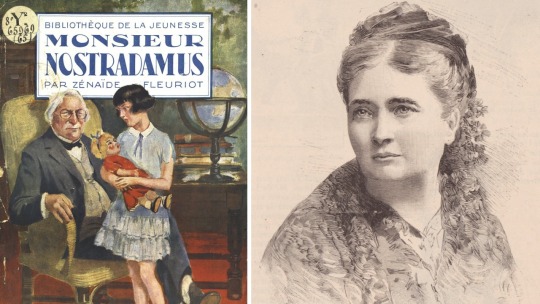
19 décembre 1890 : mort de la romancière pour la jeunesse Zénaïde Fleuriot ➽ https://bit.ly/2KuLJcz Au nombre des meilleurs romanciers du XIXe siècle pour la jeunesse, cette Bretonne de talent et d’une grande piété ne doit pas être seulement vue comme une continuatrice de la comtesse de Ségur écrivant, comme elle, dans la "Bibliothèque rose", des contes pour les enfants : les jeunes filles comme leurs parents, émus et charmés, trouvaient toujours un plaisir extrême dans ses oeuvres et y puisaient d’heureux enseignements
#CeJourLà#19Décembre#Fleuriot#Zénaïde#Romancière#Jeunesse#Bretonne#Romans#Filles#Jeunes#Lettres#Littérature#Oeuvres#Enseignement#histoire#france#history#passé#past#français#french#news#événement#newsfromthepast
3 notes
·
View notes
Photo

Pyès #MRSTRONGHAITI gen pwisans ak stabilite. Wap jwenn pyès nou yo Tout kote. Whatsapp nou : https://wa.me/message/H6BLVONNKGBQB1 Airport Industrial Park Fleuriot |31 26 0007 #haiti #motorcycle #BMFENTREPRISES #park #fleuriot #tabarre #mrstrong #pieces #motocyclette https://www.instagram.com/p/CGphAInjNrz/?igshid=1bh6ko8khjn00
0 notes
Photo

Jean Baptiste Fleuriot-Lescot, maire de Paris, dessin anonyme, s. d. (avant le 10 thermidor an II), musée Carnavalet.
16 notes
·
View notes
Photo

"Concertissimo Annullato" at Thalys
#Belgium#Brussels#Clementine Paddleford#Elke Lente#Exhibitions#Filip Gilissen#France#Group Show#Jean-Gwénolé Fleuriot#Mark Hand#Martin Nigella#Marzipanzer Lebarbier#not not nice#ON THIN ICE#Paris#petite_croix-d_amour_46#Rapunzel Twinbow#Rasa_El_Fabula#Sada Officiale H#Thalys#tr0118044y
35 notes
·
View notes
Video
77 - Lancia Stratos from 1971 by Laurent Quérité
Via Flickr:
RMCH 2024 SR 13 - St Nazaire le Désert / La Motte Chalancon Driver: Nicolas LEROY-FLEURIOT Co-driver: Mathilde YVELAIN Col de Chamauche Drôme France IMG_6373
#CanonFrance#Canonphotography#Canon EOS 7D#Canon EF-S18-135mm f/3.5-5.6 IS STM#Voiture#Automobile#Sport Mécanique#Rallye#Cars#carlovers#carphotography#Rallye Monte Carlo Historique#Col de Chamauche#Drôme#France#Lancia#Lancia Stratos#Laurent Quérité#flickr
8 notes
·
View notes
